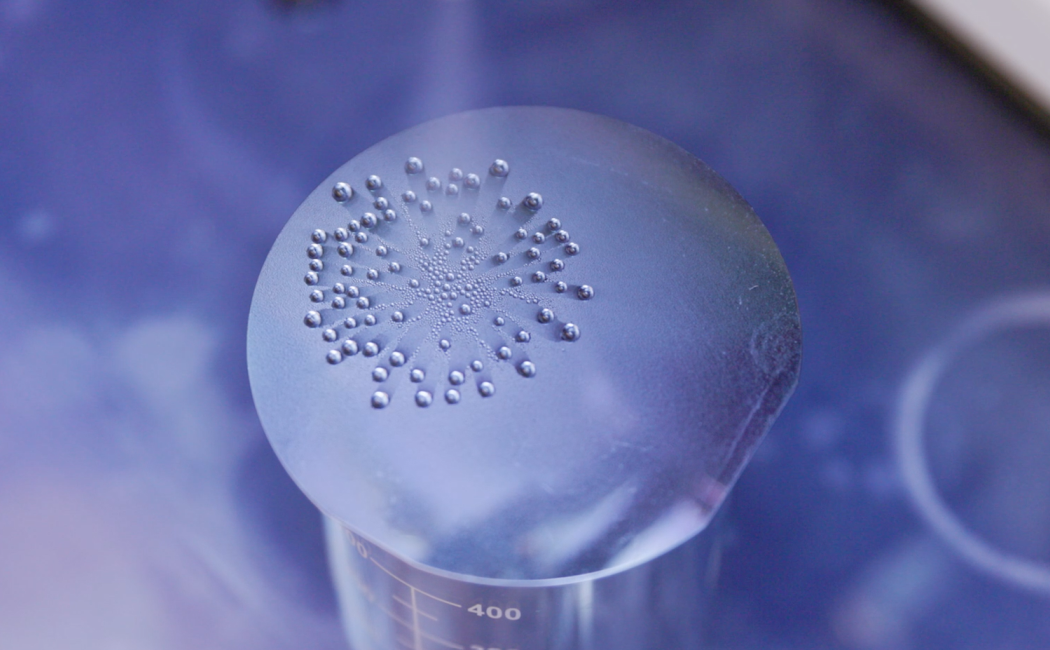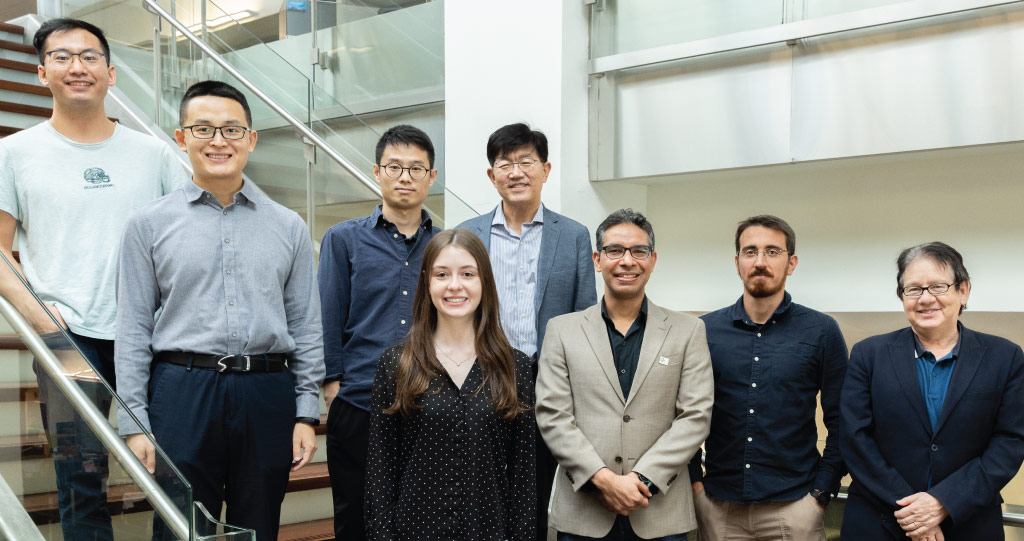


20 February, 2022
A comprehensive investigation by KAUST researchers sets the record straight on the formation of hydrogen peroxide in micrometre-sized water droplets, or microdroplets, and shows that ozone is the key to this transformation1, 2.
The air-water interface is a crucial site for numerous natural, domestic and industrial processes such as ocean-atmosphere exchange, cloud and dew formation, aerated beverages and bioreactors. Yet, probing chemical transformations at the air-water interface is challenging due to the lack of surface-specific techniques or computational models.
 The research, led by Himanshu Mishra, was the result of a collaboration of researchers from different scientific fields. From left to right: Ziqiang Yang, Xinlei Liu, Peng Zhang, Nayara H. Musskopf, Professor Hong Im, Professor Himanshu Mishra, Adair Gallo Junior and Professor Sigurdur Thoroddsen.
The research, led by Himanshu Mishra, was the result of a collaboration of researchers from different scientific fields. From left to right: Ziqiang Yang, Xinlei Liu, Peng Zhang, Nayara H. Musskopf, Professor Hong Im, Professor Himanshu Mishra, Adair Gallo Junior and Professor Sigurdur Thoroddsen.
Recent research revealed that water spontaneously transforms into 30–110 micromolar hydrogen peroxide (H2O2) in microdroplets, obtained by condensing vapor or spraying water using pressurized nitrogen gas. The textbook understanding of water is thus challenged by how the mild temperature and pressure conditions, together with the absence of catalysts, co-solvents and significant applied energy, could break covalent O–H bonds. It was hypothesized that this unusual phenomenon resulted from an ultrahigh electric field at the air-water interface that assists OH radical formation, but no direct evidence has been reported.
To delve further into this phenomenon, Himanshu Mishra assembled a team involving computational fluid dynamicists and engineers Hong Im and Sigurdur Thoroddsen. “Sprays are complex systems that can entail shock waves and rapid evaporation; so, we started with condensed water microdroplets,” says Mishra.

Professor Sigurdur Thoroddsen and Ph.D. student Ziqiang Yang provided their expertise in high-speed imaging to verify the hypothesis that water does not spontaneously transform into hydrogen peroxide.
In collaboration with Ph.D. students Adair Gallo Jr and Nayara Musskopf, research scientist Peng Zhang utilized an ultrasensitive fluorescence-based assay that can detect aqueous H2O2 with an almost 40-times lower limit of detection than the original assay. They found no H2O2 in condensed microdroplets from hot water, but up to one micromolar H2O2 in microdroplets from commercial ultrasonic humidifiers. With this key insight, the team investigated sprays.
Computer simulations by postdoc Xinlei Liu and high-speed imaging by Ph.D. student Ziqiang Yang demonstrated that bowl-shaped shock waves formed in sprays, but these conditions were inadequate to chemically transform water into H2O2.
“Questions remained: where did the rest of the H2O2 come from in the condensed and sprayed microdroplets investigated in California, and why didn’t we see it at KAUST?” says lead author Gallo Jr. After several failed attempts to explain the conundrum, the team turned to ambient ozone as a potential actor in H2O2 formation. “I had a Eureka moment while reading papers from 40 years ago. They had listed ambient ozone as an interferent in aqueous H2O2 measurements," explains Mishra.
To control ambient ozone levels, the researchers used an ozone generator and mixed the resulting gas with nitrogen gas before introducing it into a glovebox. They observed that increasing the ozone concentration enhanced H2O2 formation. “We were so happy because this was the answer,” says co-lead author Musskopf.
While ambient ozone concentrations remain below 2 parts per billion inside our glovebox, they can exceed 80 parts per billion in California, according to records collected by the Environmental Protection Agency. Although ozone minimally dissolves in water, the enhanced surface area of microdroplets allows more ozone to be dissolved and quickly react to form H2O2. “There had to be something related to the geography of the place, an environmental difference between our location in Saudi Arabia and California, Gallo Jr says.
Together, these data disprove that water spontaneously transforms into H2O2 at the air-water interface. “We have defended textbook physical chemistry and what we know about water,” Mishra concludes.